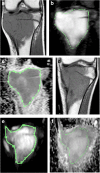Diffusion-weighted imaging in differentiating mid-course responders to chemotherapy for long-bone osteosarcoma compared to the histologic response: an update
- PMID: 33877417
- PMCID: PMC8363524
- DOI: 10.1007/s00247-021-05037-4
Diffusion-weighted imaging in differentiating mid-course responders to chemotherapy for long-bone osteosarcoma compared to the histologic response: an update
Abstract
Background: Diffusion-weighted imaging (DWI) has been described to correlate with tumoural necrosis in response to preoperative chemotherapy for osteosarcoma.
Objective: To assess the accuracy of DWI in evaluating the response to neoadjuvant chemotherapy at the mid-course treatment of long-bone osteosarcoma and in predicting survival.
Materials and methods: We conducted a prospective single-centre study over a continuous period of 11 years. Consecutive patients younger than 20 years treated with a neoadjuvant regimen for peripheral conventional osteosarcoma were eligible for inclusion. Magnetic resonance imaging (MRI) with DWI was performed at diagnosis, and mid- and end-course chemotherapy with mean apparent diffusion coefficients (ADC) calculated at each time point. A percentage less than or equal to 10% of the viable residual tissue at the histological analysis of the surgical specimen was defined as a good responder to chemotherapy. Survival comparisons were calculated using the Kaplan-Meier method. Uni- and multivariate analyses with ADC change were performed by Cox modelling. This is an expansion and update of our previous work.
Results: Twenty-six patients between the ages of 4.8 and 19.6 years were included, of whom 14 were good responders. At mid-course chemotherapy, good responders had significantly higher mean ADC values (P=0.046) and a higher increase in ADC (P=0.015) than poor responders. The ADC change from diagnosis to mid-course MRI did not appear to be a prognosticator of survival and did not impact survival rates of both groups.
Conclusion: DWI at mid-course preoperative chemotherapy for osteosarcoma should be considered to evaluate the degree of histological necrosis and to predict survival. The anticipation of a response to neoadjuvant treatment by DWI may have potential implications on preoperative management.
Keywords: Bone neoplasm; Children; Diffusion-weighted imaging; Magnetic resonance imaging; Osteosarcoma; Therapeutic response.
© 2021. The Author(s).
Conflict of interest statement
None
Figures



Similar articles
-
Value of diffusion-weighted images in differentiating mid-course responders to chemotherapy for osteosarcoma compared to the histological response: preliminary results.Skeletal Radiol. 2012 Sep;41(9):1141-9. doi: 10.1007/s00256-012-1360-2. Epub 2012 Feb 9. Skeletal Radiol. 2012. PMID: 22318350 Clinical Trial.
-
Efficacy of Diffusion-Weighted Imaging in Neoadjuvant Chemotherapy for Osteosarcoma: A Systematic Review and Meta-Analysis.Acad Radiol. 2022 Feb;29(2):326-334. doi: 10.1016/j.acra.2020.11.013. Epub 2020 Dec 30. Acad Radiol. 2022. PMID: 33386220
-
Correlation between apparent diffusion coefficient and histopathology subtypes of osteosarcoma after neoadjuvant chemotherapy.Acta Radiol. 2017 Aug;58(8):971-976. doi: 10.1177/0284185116678276. Epub 2016 Nov 16. Acta Radiol. 2017. PMID: 27852643
-
Noninvasive assessment of response to neoadjuvant chemotherapy in osteosarcoma of long bones with diffusion-weighted imaging: an initial in vivo study.PLoS One. 2013 Aug 26;8(8):e72679. doi: 10.1371/journal.pone.0072679. eCollection 2013. PLoS One. 2013. PMID: 23991141 Free PMC article.
-
Conventional 99mTc-(hydroxy) methylene diphosphate remains useful to predict osteosarcoma response to neoadjuvant chemotherapy: Individual patient data and aggregate data meta-analyses.Medicine (Baltimore). 2018 Dec;97(51):e13308. doi: 10.1097/MD.0000000000013308. Medicine (Baltimore). 2018. PMID: 30572434 Free PMC article.
Cited by
-
Multiparametric MRI evaluation of bone sarcomas in children.Insights Imaging. 2022 Mar 1;13(1):33. doi: 10.1186/s13244-022-01177-9. Insights Imaging. 2022. PMID: 35229206 Free PMC article. Review.
-
Beyond the Signal: Imaging Insights and Diagnostic Relevance of Bone Oedema in Bone Tumours and Tumour-like Lesions.Cancers (Basel). 2025 Jun 20;17(13):2074. doi: 10.3390/cancers17132074. Cancers (Basel). 2025. PMID: 40647375 Free PMC article. Review.
-
The presence of a fat layer after neoadjuvant chemotherapy as an indicator of prognosis in osteosarcoma.Front Oncol. 2025 Apr 11;15:1514560. doi: 10.3389/fonc.2025.1514560. eCollection 2025. Front Oncol. 2025. PMID: 40291910 Free PMC article.
-
Methodological considerations on segmenting rhabdomyosarcoma with diffusion-weighted imaging-What can we do better?Insights Imaging. 2023 Jan 31;14(1):19. doi: 10.1186/s13244-022-01351-z. Insights Imaging. 2023. PMID: 36720720 Free PMC article. Review.
-
Imaging of pediatric bone tumors: A COG Diagnostic Imaging Committee/SPR Oncology Committee White Paper.Pediatr Blood Cancer. 2023 Jun;70 Suppl 4(Suppl 4):e30000. doi: 10.1002/pbc.30000. Epub 2022 Oct 17. Pediatr Blood Cancer. 2023. PMID: 36250990 Free PMC article.
References
MeSH terms
LinkOut - more resources
Full Text Sources
Other Literature Sources
Medical

